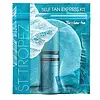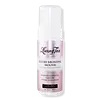What's inside
What's inside
 Key Ingredients
Key Ingredients

 Benefits
Benefits

 Concerns
Concerns

 Ingredients Side-by-side
Ingredients Side-by-side

Dihydroxyacetone
Skin ConditioningCaramel
Cosmetic ColorantPropylene Glycol
HumectantEthoxydiglycol
HumectantGlycerin
HumectantPPG-5-Ceteth-20
EmulsifyingDecyl Glucoside
CleansingPhenoxyethanol
PreservativeParfum
MaskingMelanin
Skin ProtectingCetyl Hydroxyethylcellulose
Emulsion StabilisingDimethyl Isosorbide
SolventSodium Metabisulfite
AntioxidantEthylhexylglycerin
Skin ConditioningLinalool
PerfumingBenzyl Salicylate
PerfumingCI 14700
Cosmetic ColorantHexyl Cinnamal
PerfumingCI 19140
Cosmetic ColorantCitronellol
PerfumingCI 42090
Cosmetic ColorantLimonene
PerfumingAloe Barbadensis Leaf Juice
Skin ConditioningGeraniol
PerfumingCoumarin
PerfumingAlpha-Isomethyl Ionone
PerfumingHydroxycitronellal
PerfumingPotassium Sorbate
PreservativeCitric Acid
BufferingDihydroxyacetone, Caramel, Propylene Glycol, Ethoxydiglycol, Glycerin, PPG-5-Ceteth-20, Decyl Glucoside, Phenoxyethanol, Parfum, Melanin, Cetyl Hydroxyethylcellulose, Dimethyl Isosorbide, Sodium Metabisulfite, Ethylhexylglycerin, Linalool, Benzyl Salicylate, CI 14700, Hexyl Cinnamal, CI 19140, Citronellol, CI 42090, Limonene, Aloe Barbadensis Leaf Juice, Geraniol, Coumarin, Alpha-Isomethyl Ionone, Hydroxycitronellal, Potassium Sorbate, Citric Acid
Water
Skin ConditioningDihydroxyacetone
Skin ConditioningPropylene Glycol
HumectantEthoxydiglycol
HumectantErythrulose
TanningPanthenol
Skin ConditioningDecyl Glucoside
CleansingDimethicone
EmollientPhenoxyethanol
PreservativeEthylhexylglycerin
Skin ConditioningJuglans Nigra Shell Extract
AstringentAloe Barbadensis Leaf Juice
Skin ConditioningParfum
MaskingHydroxypropyl Methylcellulose
Emulsion StabilisingSodium Bisulfite
AntioxidantCI 16035
Cosmetic ColorantCI 14700
Cosmetic ColorantCI 19140
Cosmetic ColorantCaramel
Cosmetic ColorantCI 42090
Cosmetic ColorantWater, Dihydroxyacetone, Propylene Glycol, Ethoxydiglycol, Erythrulose, Panthenol, Decyl Glucoside, Dimethicone, Phenoxyethanol, Ethylhexylglycerin, Juglans Nigra Shell Extract, Aloe Barbadensis Leaf Juice, Parfum, Hydroxypropyl Methylcellulose, Sodium Bisulfite, CI 16035, CI 14700, CI 19140, Caramel, CI 42090
Ingredients Explained
These ingredients are found in both products.
Ingredients higher up in an ingredient list are typically present in a larger amount.
Aloe Barbadensis Leaf Juice comes from leaves of the aloe plant. Aloe Barbadensis Leaf Juice is best known for helping to soothe sunburns. It is also anti-inflammatory, moisturizing, antiseptic, and can help heal wounds.
Aloe is packed with good stuff including Vitamins A, C, and E. These vitamins are antioxidants, which help fight free-radicals and the damage they may cause. Free-radicals are molecules that may damage your skin cells, such as pollution.
Aloe Barbadensis Leaf Juice also contains sugars. These sugars come in the form of monosaccharides and polysaccharides, folic acid, and choline. These sugars are able to help bind moisture to skin.
It also contains minerals such as calcium, 12 anthraquinones, fatty acids, amino acids, and Vitamin B12.
Learn more about Aloe Barbadensis Leaf JuiceWe don't have a description for Caramel yet.
Ci 14700, also known as Red No. 4, is a synthetic red dye derived from petroleum. It is water soluble.
CI 19140 is also known as Tartrazine. Tartrazine is a synthetic dye used in cosmetics, foods, and medicine to add a yellow color.
Tartrazine is created from petroleum and is water-soluble.
Some people may experience allergies from this dye, especially asthmatics and those with an aspirin intolerance.
Learn more about CI 19140Ci 42090 is a synthetic dye created from petroleum. It is used to give a bright blue color to cosmetics, medicine, and food.
Decyl Glucoside is a glucose-based surfactant and emulsion stabilizer. It is created by reacting glucose with the fatty acids from plants.
Surfactants help clean the skin by trapping oil, sebum, and dirt to be washed away. As an emulsion stabilizer, it stabilizes the ingredients in a product by preventing them from separating.
This ingredient is biodegradable and non-toxic. This ingredient is commonly found in baby shampoos.
Decyl Glucoside is sometimes used to stabilize the UV filter Tinosorb.
Learn more about Decyl GlucosideDihydroxyacetone, or DHA, is a simple sugar. It is frequently used in self-tanning products.
DHA binds to the amino acids in your dead skin cells to create a brown/orange color. Darkening begins to kick in a few hours after application and will continue to develop for up to 3 days. This ingredient can be drying.
Both the US and the EU have approved DHA in self-tanning products. In the EU, DHA is allowed at a maximum concentration of 10%. Most tanning products usually contain amounts between 3-5%.
If you are pregnant or have underlying medical conditions, it is best to speak with a dermatologist about using self-tanning products.
Learn more about DihydroxyacetoneEthoxydiglycol is a synthetic solvent.
Solvents are used to keep ingredients together in a product. They can help dissolve ingredients to stable bases or help evenly distribute ingredients throughout the product.
Ethoxydiglycol also helps deliver other key ingredients into the skin.
Learn more about EthoxydiglycolEthylhexylglycerin (we can't pronounce this either) is commonly used as a preservative and skin softener. It is derived from glyceryl.
You might see Ethylhexylglycerin often paired with other preservatives such as phenoxyethanol. Ethylhexylglycerin has been found to increase the effectiveness of these other preservatives.
Parfum is a catch-all term for an ingredient or more that is used to give a scent to products.
Also called "fragrance", this ingredient can be a blend of hundreds of chemicals or plant oils. This means every product with "fragrance" or "parfum" in the ingredients list is a different mixture.
For instance, Habanolide is a proprietary trade name for a specific aroma chemical. When used as a fragrance ingredient in cosmetics, most aroma chemicals fall under the broad labeling category of “FRAGRANCE” or “PARFUM” according to EU and US regulations.
The term 'parfum' or 'fragrance' is not regulated in many countries. In many cases, it is up to the brand to define this term.
For instance, many brands choose to label themselves as "fragrance-free" because they are not using synthetic fragrances. However, their products may still contain ingredients such as essential oils that are considered a fragrance by INCI standards.
One example is Calendula flower extract. Calendula is an essential oil that still imparts a scent or 'fragrance'.
Depending on the blend, the ingredients in the mixture can cause allergies and sensitivities on the skin. Some ingredients that are known EU allergens include linalool and citronellol.
Parfum can also be used to mask or cover an unpleasant scent.
The bottom line is: not all fragrances/parfum/ingredients are created equally. If you are worried about fragrances, we recommend taking a closer look at an ingredient. And of course, we always recommend speaking with a professional.
Learn more about ParfumPhenoxyethanol is a preservative that has germicide, antimicrobial, and aromatic properties. Studies show that phenoxyethanol can prevent microbial growth. By itself, it has a scent that is similar to that of a rose.
It's often used in formulations along with Caprylyl Glycol to preserve the shelf life of products.
Propylene Glycol is an odorless, colorless liquid. As a humectant, it helps skin retain moisture. It also aids in delivering active ingredients.
Another role of this ingredient is preventing a product from melting or freezing. Propylene glycol also adds antimicrobrial properties to a product, elongating product lifespan.
This ingredient is considered an organic alcohol and commonly added into both cosmetics and foods.
Those with sensitive skin or conditions may develop a rash when using this ingredient.
Learn more about Propylene Glycol